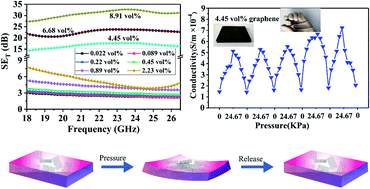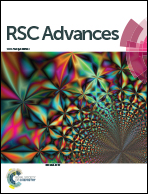Flexible PEBAX/graphene electromagnetic shielding composite films with a negative pressure effect of resistance for pressure sensors applications†
Abstract
In the current work, we fabricated flexible poly(ether-block-amide) (PEBAX)/graphene composite films by a combination of facile melt blending and compression molding technique. The graphene content significantly affects the mechanical properties, electrical conductivity and electromagnetic interference (EMI) shielding performance. An electrically conductive percolation threshold of 1.75 vol% graphene was obtained in the PEBAX/graphene composites. With the introduction of 4.45 vol%, and 8.91 vol% graphene content, the average EMI SE of composite films could reach 16.6 and 30.7 dB, respectively. More interestingly, the PEBAX/graphene composite exhibited a nearly-linear negative pressure coefficient (NPC) effect of resistance with increasing outer pressure stimulation, which was attributed to the formation of more conductive pathways caused by the decreased distance between adjacent graphene. In addition, these composites demonstrated good sensing stability, recoverability and reproducibility after stabilization by cyclic pressure loading. The current study provides guidelines for the large-scale preparation of elastomer NPC sensors and smart EMI shielding devices.



 Please wait while we load your content...
Please wait while we load your content...